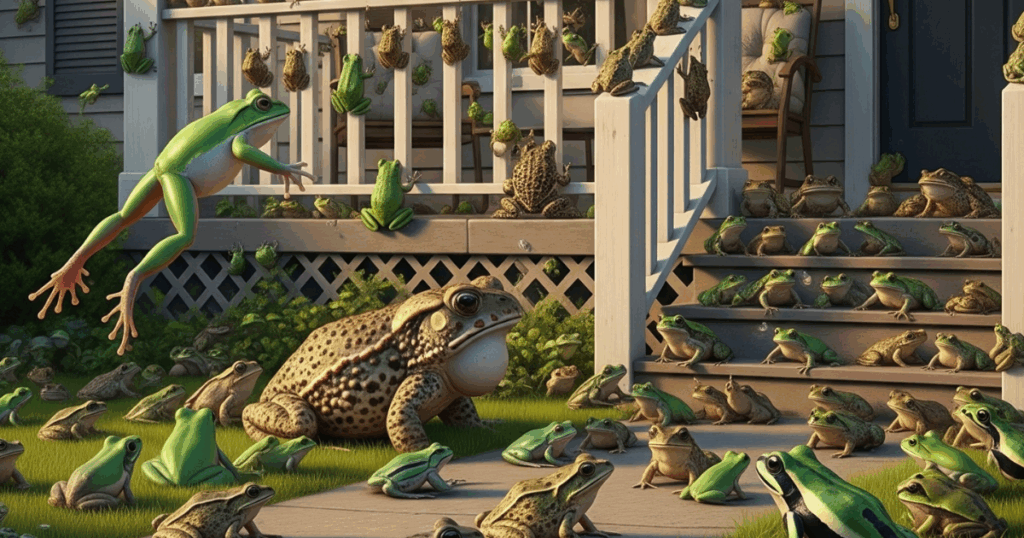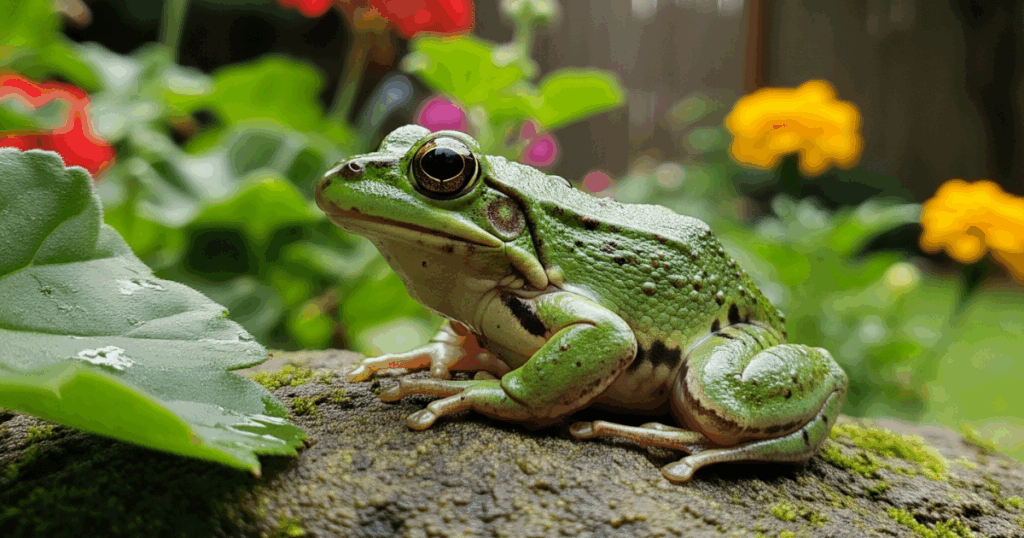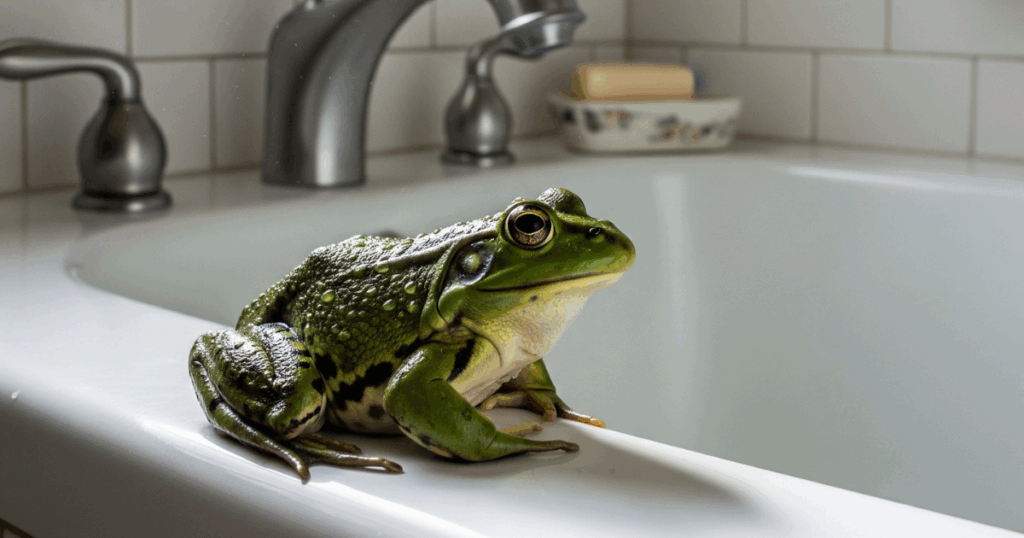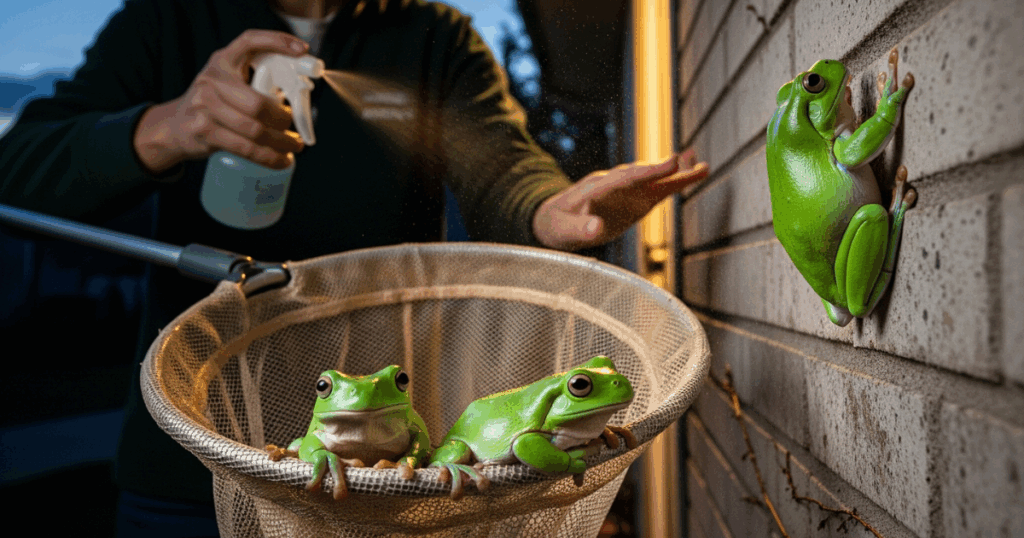Picture this: you step outside for your morning coffee and discover dozens of small green frogs covering your patio, or you walk into your bathroom late at night only to find a large tree frog perched on your toilet seat. While frogs are beneficial creatures that control insect populations, their presence in and around your home can become overwhelming and problematic. Understanding how to get rid of frogs effectively requires knowledge of their behavior, habitat preferences, and safe removal methods that don’t harm these important amphibians or your family.
Frogs are attracted to moisture, food sources, and shelter, which makes residential properties particularly appealing during certain seasons. Whether you’re dealing with how to get rid of frogs from my backyard ponds and gardens, how to get rid of frogs in bathroom fixtures, or how to get rid of green tree frogs in your outdoor spaces, the key lies in addressing the root causes while using humane deterrent methods.
Table of Contents
Understanding Why Frogs Invade Your Property?

Frogs don’t randomly choose properties to inhabit. They’re drawn to specific environmental conditions that meet their survival needs. Understanding these attractants is crucial for anyone wondering how to get rid of frogs at home or seeking long-term prevention strategies.
Amphibians require moisture for skin respiration and reproduction, making areas with standing water, high humidity, or consistent moisture sources highly attractive. Your property might unknowingly provide ideal conditions through leaky pipes, clogged gutters, overwatered gardens, or poorly drained areas. Additionally, outdoor lighting attracts insects, which in turn draws frogs seeking easy meals.
Temperature regulation is another critical factor. Frogs are cold-blooded creatures that seek warm, sheltered areas during cooler periods and cool, shaded spots during hot weather. This behavior explains why you might find them in basements, under decks, or even inside homes where temperatures remain more stable than outdoor conditions.
To effectively deter or remove frogs, focus on eliminating their food source, removing their habitat, and using natural repellents. This includes reducing insect populations, removing standing water and hiding places, and using vinegar or other deterrents around your property.
Here’s a more detailed approach:
1. Reduce their food source:
- Control insects: Frogs primarily eat insects. Reducing insect populations in your yard will make it less attractive to frogs. This can be done by using insecticidal treatments and eliminating breeding grounds for insects, such as standing water.
- Limit outdoor lighting: Insects are attracted to bright lights, which in turn attract frogs. Turn off or reduce the use of outdoor lights, especially at night.
- Remove pet food and garbage: Pet food and garbage can also attract insects, which frogs will feed on.
2. Remove their habitat:
- Eliminate standing water: Remove any sources of standing water, such as bird baths, clogged gutters, and containers that collect rainwater. Frogs need water to breed and lay their eggs.
- Reduce hiding places: Keep your lawn mowed, trim bushes, and remove debris like leaf piles and woodpiles. This will make it harder for frogs to find shelter.
- Secure entry points:Seal any cracks or openings in your foundation or around doors and windows to prevent frogs from entering your home.
3. Use natural repellents:
- Vinegar: Mix equal parts vinegar and water and spray it in areas where you see frogs. The vinegar can irritate their skin and discourage them from staying.
- Other natural repellents: Some people also report success with coffee grounds, baking soda, or lemon juice as deterrents.
- Consider natural predators: If you have snakes, lizards, or birds, they can help control frog populations.
4. Humane removal:
- Gently guide them out: If you find a frog in your house, gently guide it towards an open door or window using a broom or piece of cardboard.
Use a jar and cloth :If you need to remove a frog from a specific area, you can use a jar with a lid and a piece of cloth. Carefully cover the frog with the cloth, gently place it in the jar, and release it outside.
Common Frog Attractants
| Attractant Category | Specific Examples | Location | Appeal to Frogs | Prevention Method |
| Water Sources | – Standing water- Birdbaths- Clogged gutters- Leaky pipes | – Ponds- Containers- Under eaves- Near faucets | Breeding sites and hydration | – Empty containers- Fix leaks- Clean gutters- Improve drainage |
| Food Sources | – Insects- Small invertebrates- Garden pests | – Around lights- In gardens- Near compost | Primary nutrition source | – Reduce lighting- Use yellow bulbs- Manage compost |
| Shelter Options | – Woodpiles- Dense vegetation- Rock piles- Storage areas | – Backyards- Basements- Under decks | Protection and temperature control | – Organize storage- Trim plants- Seal spaces |
| Temperature Control | – Warm concrete- Shade areas- Cool basements | – Patios- Under trees- Indoor spaces | Thermoregulation needs | – Remove heat sources- Increase airflow- Seal entries |
How to Get Rid of Frogs from My Backyard?

Backyard frog management requires a systematic approach that addresses habitat modification, food source elimination, and humane deterrent methods. The goal isn’t to harm these beneficial creatures but to make your outdoor space less appealing while encouraging them to relocate to more suitable natural habitats.
Moisture Control Strategies
The most effective method for how to get rid of frogs from my backyard involves eliminating excess moisture sources. Water management forms the foundation of successful frog deterrent strategies.
Primary Moisture Sources to Address:
- Fix all leaking irrigation systems immediately
- Adjust sprinkler timing to avoid overwatering
- Repair dripping outdoor faucets and hoses
- Clear clogged gutters and downspouts
- Install proper drainage in low-lying areas
- Address air conditioning condensation issues
Drainage Improvement Techniques:
- Install French drains in problem areas
- Add organic matter to improve soil absorption
- Regrade landscape to direct water away from home
- Create rain gardens for natural water management
- Use permeable materials for walkways and patios
Habitat Modification Techniques
Strategic habitat modification makes your backyard less attractive to frogs without completely eliminating natural elements that benefit other wildlife.
| Modification Type | Action Required | Frequency | Expected Results |
| Vegetation Management | – Trim overgrown bushes- Remove leaf litter- Thin dense plantings- Eliminate ground cover | Monthly during growing season | Reduces hiding spots by 60-80% |
| Water Feature Maintenance | – Add circulation pumps- Install UV sterilizers- Stock with fish- Clean regularly | Weekly cleaning, seasonal equipment checks | Decreases frog breeding success by 70% |
| Storage Organization | – Elevate stored items- Create air gaps- Use sealed containers- Regular cleaning | Seasonal reorganization | Eliminates 90% of shelter options |
| Lighting Modifications | – Install motion sensors- Use yellow bulbs- Reduce night lighting- Shield lights downward | One-time installation with annual bulb replacement | Reduces insect attraction by 50% |
Natural Deterrent Methods
Several natural substances can discourage frogs without causing harm to the amphibians or your garden ecosystem.
Coffee Ground Applications:
- Spread used grounds around problem areas
- Reapply after rain or heavy watering
- Mix with soil for dual benefit
- Focus on borders and pathways
- Use organic, pesticide-free grounds only
Citrus-Based Repellents:
- Place fresh peels around frog gathering spots
- Create citrus spray by boiling peels in water
- Apply weekly for consistent effectiveness
- Combine with other natural methods
- Safe for pets and children
How to Get Rid of Frogs in the House and Bathroom?

Finding frogs inside your home, particularly in bathrooms, can be disturbing and requires immediate attention. How to get rid of frogs in the house involves both removal of current inhabitants and prevention of future intrusions through comprehensive sealing and moisture management strategies.
Immediate Removal Techniques
When you discover how to get rid of frogs in bathroom or other indoor areas, follow these safe and effective removal methods:
Safe Capture Methods:
- Use large containers or buckets for gentle capture
- Slide cardboard underneath to create secure lid
- Avoid direct hand contact with frogs
- Move slowly to prevent frog from hiding
- Release immediately outdoors away from home
Frog Highway Technique:
- Create moisture trail using damp towels
- Lead from hiding spot to nearest exit
- Place towels in straight line to door
- Wait patiently for frog to follow trail
- Works best during evening hours
Entry Point Sealing Strategy
| Entry Point Type | Common Locations | Sealing Materials | Inspection Frequency |
| Door Gaps | – Under entry doors- Around door frames- Pet doors | – Weather stripping- Door sweeps- Caulk | Every 6 months |
| Window Issues | – Torn screens- Frame gaps- Sill cracks | – Screen patches- Mesh replacement- Silicone sealant | Seasonal inspection |
| Foundation Problems | – Wall cracks- Pipe penetrations- Utility entries | – Hydraulic cement- Expanding foam- Steel wool + caulk | Annual assessment |
| Ventilation Points | – Bathroom fans- Dryer vents- Attic vents | – Fine mesh screening- Vent covers- Weatherproof barriers | Bi-annual check |
Humidity and Moisture Management
Indoor moisture control is essential for long-term frog prevention and overall home health.
Humidity Control Measures:
- Install and maintain dehumidifiers in basements
- Use exhaust fans during and after showers
- Fix all plumbing leaks immediately
- Ensure proper HVAC ventilation
- Monitor humidity levels with digital meters
- Maintain indoor humidity between 30-50%
Bathroom-Specific Strategies:
- Run exhaust fans for 30 minutes after showers
- Repair grout and caulk around tubs and showers
- Check under-sink areas for leaks monthly
- Keep bathroom doors open when not in use
- Address any water damage promptly
How to Get Rid of Green Tree Frogs and Specific Species?

Different frog species require tailored approaches based on their unique behaviors, habitat preferences, and activity patterns. How to get rid of green tree frogs involves understanding their arboreal nature and preference for vegetation near water sources.
Species Identification and Behavior Patterns
| Frog Species | Physical Characteristics | Preferred Habitat | Activity Patterns | Removal Difficulty |
| Green Tree Frogs | – Bright green color- 1-2 inches long- Adhesive toe pads- Smooth skin | – Trees near water- Shrubs and bushes- Window areas- Outdoor lighting | – Most active at night- Climb vertical surfaces- Attracted to insects | Moderate |
| Common Frogs | – Brown/green coloring- 2-4 inches long- Webbed feet- Moist skin | – Ground level- Under debris- Near water sources- Damp areas | – Active dawn/dusk- Stay close to water- Hide during day | Easy |
| Bull Frogs | – Large size (4-8 inches)- Green/brown pattern- Prominent ears- Deep calls | – Ponds and streams- Large water bodies- Muddy areas- Cattail marshes | – Very loud calls- Aggressive behavior- Year-round activity | Difficult |
| Spring Peepers | – Small (0.75-1.5 inches)- Light brown/tan- X-shaped back marking- High-pitched calls | – Wooded areas- Temporary pools- Brush piles- Moist leaf litter | – Spring activity peak- Chorus calling- Hide in vegetation | Easy to Moderate |
Green Tree Frog-Specific Removal Strategies
Vegetation Management:
- Trim tree branches away from house walls
- Remove climbing plants from exterior walls
- Create 3-foot clearance between plants and structures
- Focus on areas near windows and doors
- Maintain plants at ground level rather than allowing vertical growth
Lighting Modifications:
- Install motion-activated security lighting
- Replace white bulbs with yellow or amber alternatives
- Shield lights to direct illumination downward
- Reduce unnecessary outdoor lighting
- Time lights to minimize evening insect activity
How to Get Rid of Frogs Home Remedies and Natural Solutions?
Many homeowners prefer how to get rid of frogs home remedies that avoid commercial chemicals and provide environmentally friendly alternatives. These natural methods can be highly effective when applied correctly and consistently.
Natural Repellent Effectiveness Chart
| Home Remedy | Active Ingredient | Application Method | Coverage Area | Reapplication Schedule | Effectiveness Rating |
| Coffee Grounds | Caffeine + Acidity | Scatter around borders | 10-15 sq ft per cup | Weekly or after rain | 8/10 |
| Citrus Peels | Essential oils | Place whole or spray liquid | 5-10 sq ft per application | Every 3-5 days | 7/10 |
| Garlic Solution | Sulfur compounds | Spray application | 100 sq ft per batch | Weekly | 6/10 |
| Salt Barriers | Sodium chloride | Sprinkle sparingly | Linear barriers only | Until dissolved | 5/10 |
| Essential Oils | Concentrated plant oils | Dilute and spray | 50 sq ft per application | Every 4-6 days | 7/10 |
Coffee Ground Applications
Used coffee grounds serve as an excellent natural deterrent for frogs while providing additional benefits to your garden ecosystem.
Application Guidelines:
- Use only organic, pesticide-free coffee grounds
- Apply in thin, even layers around problem areas
- Focus on garden borders, pathways, and entry points
- Mix with existing mulch for aesthetic appeal
- Store extra grounds in breathable containers
- Source from local coffee shops for larger quantities
Benefits Beyond Frog Deterrence:
- Adds organic matter to soil as grounds decompose
- Provides slight acidification beneficial for acid-loving plants
- Improves soil drainage and structure
- Attracts earthworms that aerate soil
- Creates natural barriers against other garden pests
Essential Oil Solutions
Essential oils provide powerful natural frog deterrent properties while offering pleasant fragrances for human enjoyment.
Most Effective Essential Oil Combinations:
- Peppermint + Eucalyptus: Strong scent barrier effective for 4-6 days
- Lemon + Tea Tree: Natural antiseptic properties with frog-repelling effects
- Lavender + Rosemary: Pleasant for humans, deterrent for amphibians
- Citronella + Lemongrass: Traditional insect repellent that also deters frogs
Proper Dilution and Application:
- Mix 10-15 drops essential oil per cup of water
- Add 1 teaspoon carrier oil or liquid soap for better mixing
- Spray during cooler parts of day to prevent evaporation
- Test small areas first to ensure no plant damage
- Store mixed solutions in dark bottles to preserve potency
How to Get Rid of Frog Neck and Health Considerations?
While “frog neck” typically refers to a medical condition rather than literal frog removal, understanding how to get rid of frog neck in the context of this article involves addressing any health concerns related to frog presence in your environment.
Health Risk Assessment and Prevention
| Risk Category | Potential Issues | Vulnerable Populations | Prevention Measures |
| Bacterial Contamination | – Salmonella transmission- E. coli exposure- Skin infections- Wound contamination | – Children under 5- Elderly individuals- Immunocompromised persons- Pregnant women | – Hand washing after contact- Wear gloves when handling- Disinfect contact areas- Avoid direct skin contact |
| Allergic Reactions | – Skin irritation- Respiratory issues- Contact dermatitis- Eye irritation | – Allergy sufferers- Asthma patients- Sensitive individuals- Pet owners | – Minimize direct exposure- Use protective equipment- Maintain clean environment- Seek medical advice if needed |
| Toxic Secretions | – Skin burning- Mucous membrane irritation- Digestive upset if ingested- Eye damage | – All household members- Pets and animals- Outdoor workers | – Never handle unknown species- Educate family members- Keep pets supervised- Emergency contact information |
Safe Cleaning Procedures
After removing frogs from indoor areas, follow comprehensive cleaning protocols to ensure family safety and prevent health risks.
Immediate Cleaning Steps:
- Wear disposable gloves during all cleaning activities
- Ventilate areas thoroughly before beginning work
- Remove any visible frog droppings or secretions
- Wipe surfaces with disinfectant solution (1:10 bleach ratio)
- Allow disinfectant contact time of at least 10 minutes
- Rinse treated surfaces with clean water after disinfection
Deep Cleaning Protocol:
- Steam clean carpets and upholstery where frogs were present
- Wash all removable fabric items in hot water (minimum 140°F)
- Scrub hard surfaces with antimicrobial cleaners
- Replace air filters in HVAC systems if contamination suspected
- Dispose of cleaning materials in sealed plastic bags
- Wash hands thoroughly with soap and warm water
Long-Term Prevention and Maintenance Strategies
Successful frog management requires ongoing attention and maintenance rather than one-time solutions. How to get rid of frogs at home effectively involves creating a comprehensive prevention plan that addresses seasonal changes, property maintenance, and environmental factors.
Comprehensive Annual Maintenance Schedule
| Season | Primary Focus | Key Activities | Expected Outcomes |
| Spring (March-May) | Assessment & Preparation | – Inspect winter damage- Assess frog populations- Plan habitat modifications- Service drainage systems- Prepare natural repellents | – Baseline population count- Identify problem areas- Ready prevention tools- Optimal preparation timing |
| Summer (June-August) | Active Management | – Apply natural deterrents- Monitor moisture levels- Maintain vegetation- Seal entry points- Track effectiveness | – Peak prevention period- Maximum deterrent effect- Reduced frog activity- Problem area control |
| Fall (September-November) | Preparation & Cleanup | – Remove leaf litter- Clear debris piles- Final drainage checks- Winter shelter elimination- Stock prevention supplies | – Reduced overwintering sites- Improved water flow- Prepared for cold season- Supply readiness |
| Winter (December-February) | Planning & Maintenance | – Plan next year’s strategy- Repair weather damage- Monitor indoor humidity- Research new methods- Assess annual success | – Strategic planning time- Maintenance completion- Knowledge improvement- Performance evaluation |
Property Assessment Techniques
Regular property assessment helps identify potential frog attractants and measure the success of prevention efforts.
Weekly Inspection Points:
- Check all outdoor water sources for standing water
- Examine areas under decks, porches, and overhangs
- Monitor moisture levels in basements and crawl spaces
- Assess vegetation growth and trimming needs
- Document any frog sightings with locations and numbers
Monthly Detailed Assessment:
- Use moisture meters to identify consistently damp areas
- Photograph problem areas for comparison over time
- Test soil drainage in various yard locations
- Evaluate effectiveness of current deterrent methods
- Plan adjustments to prevention strategies
Environmental Balance Considerations
Effective frog management maintains ecological balance while protecting your property and family from unwanted amphibian presence.
Ecosystem-Friendly Approaches:
- Create alternative habitats away from living areas
- Maintain beneficial insect populations for natural pest control
- Use native plants that support local ecosystem health
- Provide water sources distant from home structures
- Support natural predators that help control frog populations
Wildlife Corridor Management:
- Design landscape to guide frogs away from homes
- Create natural barriers using appropriate plant selections
- Maintain wild areas at property edges for frog habitat
- Balance human needs with environmental responsibility
- Support local ecosystem health while managing problems
Professional Intervention and When to Seek Help?
While many frog problems can be addressed through DIY methods, certain situations require professional intervention. Large-scale infestations, protected species concerns, or situations involving health risks may necessitate expert assistance from wildlife control professionals or pest management specialists.
Professional Service Comparison
| Service Type | Typical Cost Range | Services Included | Best For | Timeline |
| Wildlife Control Consultation | 750-1500 | – Property assessment- Species identification- Custom recommendations- Prevention planning | – Complex situations- Protected species- Large properties- Multiple problem areas | 1-2 weeks |
| Habitat Modification Service | 2000-8000 | – Drainage improvements- Vegetation management- Entry point sealing- Moisture control systems | – Comprehensive solutions- Property-wide issues- Long-term prevention- Professional installation | 2-4 weeks |
| Ongoing Maintenance Program | 1000-3000/quarter | – Regular inspections- Seasonal treatments- Monitoring and reporting- Adjustment recommendations | – Persistent problems- High-value properties- Peace of mind- Busy homeowners | Ongoing |
| Emergency Response | 1500-4000 | – Immediate assessment- Safe frog removal- Health risk evaluation- Urgent prevention measures | – Health concerns- Large infestations- Dangerous species- Immediate relief needed | Same day |
When Professional Help is Recommended?
Immediate Professional Intervention Required:
- Suspected protected or endangered species present
- Family members experiencing health reactions
- Large-scale infestations exceeding 50+ individuals
- Frogs appearing in multiple indoor locations
- Unknown species with potential toxicity risks
- Property damage from frog activity
Professional Consultation Beneficial:
- DIY methods unsuccessful after 8-12 weeks
- Recurring infestations despite prevention efforts
- Complex property layouts requiring specialized solutions
- Need for species identification and risk assessment
- Desire for comprehensive, long-term management plan
Conclusion
Learning how to get rid of frogs effectively requires a balanced approach that combines immediate removal techniques with long-term prevention strategies. Whether you’re addressing how to get rid of frogs from my backyard, how to get rid of frogs in bathroom areas, or dealing with how to get rid of green tree frogs around your property, success depends on understanding frog behavior and creating environments that are less attractive to these amphibians.
For comprehensive and hassle-free frog removal and long-term pest prevention, trust the professionals at Antipest Office. Visit us at the Antipest Office, Our trained technicians use safe and effective methods to protect your home and business. For service bookings and consultations, call us at +91 9819018398 .
How to Get Rid of Frogs? – FAQs
How to get rid of frogs around the house quickly?
Seal cracks, remove water sources, and keep outdoor lights dim to reduce insect activity (their food source). Motion-sensor lights can also scare frogs away.
How to Get Rid of frogs without harming them?
Eliminate water sources, use natural repellents like vinegar spray, and relocate them manually to nearby ponds or wetlands.
How to get rid of frogs from my swimming pool?
Cover the pool when not in use, use a pool net to remove frogs, and install a pool fence or netting around it to prevent entry.
How to get rid of frogs using home remedies?
Simple remedies include sprinkling salt around entry points, spraying vinegar-water solution, or spreading coffee grounds in damp areas where frogs gather.
How to get rid of frogs humanely?
Relocate frogs to nearby ponds or wooded areas and make your property less attractive by removing standing water and insects.
How to get rid of frogs permanently?
Maintain a dry, well-lit, and clean yard, eliminate insect breeding grounds, and use long-term deterrents like netting, fencing, or ultrasonic repellents.
How to get rid of frogs in rainy season?
Drain excess water, clean gutters, and keep grass trimmed. Since rain attracts insects, use bug zappers or repellents to cut down frog food sources.
How to get rid of frogs in my garden without harming plants?
Use non-toxic deterrents like vinegar, citrus peels, or coffee grounds around garden beds. Also, reduce water sources to discourage frogs without affecting plants.
How to get rid of frogs from walls and windows?
Apply repellents near walls, keep windows closed, and install mesh screens. Turning off outdoor lights also reduces insects that attract frogs.
How to get rid of frogs safely at night?
Use a flashlight and gloves to gently relocate them, or discourage them by spraying a vinegar solution in entry areas without causing harm.

